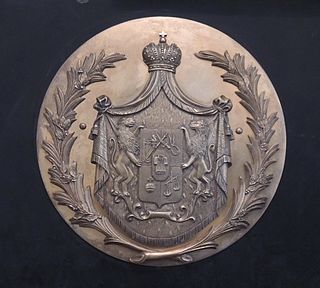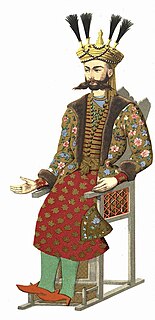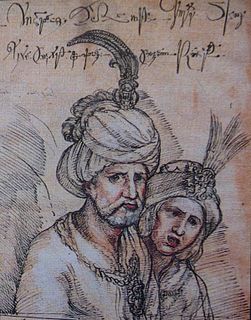Related Research Articles

The Kingdom of Kartli-Kakheti (1762–1801) was created in 1762 by the unification of two eastern Georgian kingdoms of Kartli and Kakheti. From the early 16th century, according to the 1555 Peace of Amasya, these two kingdoms were under Iranian control. In 1744, Nader Shah granted the kingship of Kartli to Teimuraz II and that of Kakheti to his son Heraclius II, as a reward for their loyalty. When Nader Shah died in 1747, Teimuraz II and Heraclius II capitalized on the instability in Iran proper, and declared de facto independence. After Teimuraz II died in 1762, Heraclius succeeded him as ruler of Kartli, thus unifying the two.

Heraclius II, also known as Erekle II and The Little Kakhetian, was a Georgian monarch of the Bagrationi dynasty, reigning as the king of Kakheti from 1744 to 1762, and of Kartli and Kakheti from 1762 until 1798. In the contemporary Persian sources he is referred to as Erekli Khan, while Russians knew him as Irakly (Ираклий). His name is frequently transliterated in a Latinized form Heraclius because both names Erekle and Irakli are Georgian versions of this Greek name.

The Battle of Krtsanisi was fought between the Qajar Iran (Persia) and the Georgian armies of the Kingdom of Kartli-Kakheti and Kingdom of Imereti at the place of Krtsanisi near Tbilisi, Georgia, from September 8 to September 11, 1795, as part of Agha Mohammad Khan Qajar's war in response to King Heraclius II of Georgia’s alliance with the Russian Empire. The battle resulted in the decisive defeat of the Georgians, capture, and complete destruction of their capital Tbilisi, as well as the temporary absorption of eastern parts of Georgia into the Iranian Empire.

George XI, known as Gurgin Khan in Iran, was a Georgian monarch who ruled the Kingdom of Kartli as a Safavid Persian subject from 1676 to 1688 and again from 1703 to 1709. He is best known for his struggle against the Safavids which dominated his weakened kingdom and later as a Safavid commander-in-chief in what is now Afghanistan. Being an Eastern Orthodox Christian, he converted to Shia Islam prior to his appointment as governor of Kandahar.
The Russo-Persian Wars or Russo-Iranian Wars were a series of conflicts between 1651 and 1828, concerning Persia (Iran) and the Russian Empire. Russia and Persia fought these wars over disputed governance of territories and countries in the Caucasus. The main territories disputed were Aran, Georgia and Armenia, as well as much of Dagestan – generally referred to as Transcaucasia – and considered part of the Safavid Iran prior to the Russo-Persian Wars. Over the course of the five Russo-Persian Wars, the governance of these regions transferred between the two empires. Between the Second and Third Russo-Persian Wars, there was an interbellum period in which a number of treaties were drawn up between the Russian and the Persian Empires, as well as between both parties and the Ottoman Empire. Ottoman interest in these territories further complicated the wars, with both sides forming alliances with the Ottoman Empire at different points throughout the wars. Following the Treaty of Turkmenchay, which concluded the Fifth Russo-Persian War, Persia ceded much of its Transcaucasian territory to the Russian Empire.

Teimuraz II (1680/1700–1762) of the Bagrationi dynasty, was a king of Kakheti, eastern Georgia, from 1732 to 1744, then of Kartli from 1744 until his death. Teimuraz was also a lyric poet.

The Bagrationi dynasty is a royal dynasty which reigned in Georgia from the Middle Ages until the early 19th century, being among the oldest extant Christian ruling dynasties in the world. In modern usage, the name of the dynasty is sometimes Hellenized and referred to as the Georgian Bagratids, also known in English as the Bagrations.

Constantine II also known as Mahmād Qulī Khān in Iran, was a king of Kakheti in eastern Georgia of the Bagrationi Dynasty from 1722 to 1732.

Archil, of Bagrationi dynasty, king of Imereti in western Georgia and of Kakheti in eastern Georgia (1664–75). After a series of unsuccessful attempts to establish himself on the throne of Imereti, Archil retired to Russia where he spearheaded the cultural life of a local Georgian community. He was also a lyric poet.

The Second Kingdom of Kakheti was a late medieval/early modern monarchy in eastern Georgia, centered at the province of Kakheti, with its capital first at Gremi and then at Telavi. It emerged in the process of a tripartite division of the Kingdom of Georgia in 1465 and existed, with several brief intermissions, until 1762 when Kakheti and the neighboring Georgian kingdom of Kartli were merged through a dynastic succession under the Kakhetian branch of the Bagrationi dynasty. Through most of its turbulent history, Kakheti was tributary to the Persians, whose efforts to keep the reluctant Georgian kingdom within its sphere of influence resulted in a series of military conflicts and deportations.

Levan also known as Leon (1503–1574), of the Bagrationi Dynasty, was a king of Kakheti in eastern Georgia from 1518/1520 to 1574. He presided over the most prosperous and peaceful period in the history of the Kingdom of Kakheti.

Alexander II of the Bagrationi Dynasty, was a king of Kakheti in eastern Georgia from 1574 to 1605. In spite of a precarious international situation, he managed to retain relative economic stability in his kingdom and tried to establish contacts with the Tsardom of Russia. Alexander fell victim to the Iran-sponsored coup led by his own son, Constantine I.
Constantine I, also known as Constantine Khan, Constantin(e) Mirza, or Konstandil / Kustandil Mirza, of the Bagrationi Dynasty, was a king of Kakheti in eastern Georgia from March to October 1605.

David II also known as Imām Qulī Khān, of the Bagrationi Dynasty, was a king of Kakheti in eastern Georgia from 1709 to 1722. Although a Muslim and a loyal vassal of the Safavid dynasty of Iran, he failed to ensure his kingdom’s security and most of his reign was marked by Lekianoba - incessant inroads by the Dagestani mountainous clansmen.

Teimuraz I (1589–1661), of the Bagrationi Dynasty, was a Georgian monarch who ruled, with intermissions, as King of Kakheti from 1605 to 1648 and also of Kartli from 1625 to 1633. The eldest son of David I and Ketevan, Teimuraz spent most of his childhood at the court of Shah of Iran, where he came to be known as Tahmuras Khan. He was made king of Kakheti following a revolt against his reigning uncle, Constantine I, in 1605. From 1614 on, he waged a five-decade long struggle against the Safavid Iranian domination of Georgia in the course of which he lost several members of his family and ended up his life as the shah's prisoner at Astarabad at the age of 74.

Givi Amilakhvari (1689–1754) was a Georgian nobleman (tavadi) with a prominent role in the politics of eastern Georgia in the first half of the 18th century. He waged a lengthy struggle against the Ottoman and Iranian encroachments, changing sides and forging various alliances as he tried to preserve autonomy for his native kingdom of Kartli as well as to prevent the ascendant Bagrationi dynasty of the neighboring Georgian kingdom of Kakheti from seizing the throne of Kartli. In the closing years of his turbulent life, Amilakhvari stood by his erstwhile Kakhetian foes and sponsored several construction projects across the country.

Nestan-Darejan was queen consort of Kartli, a kingdom in eastern Georgia, as the wife of King Simon I, whom she married in 1559. Nestan-Darejan was a daughter of King Levan of Kakheti and a half-sister of Levan's successor to the throne of Kingdom of Kakheti, Alexander II. Her husband spent nearly five decades fighting the Safavid Iranian and Ottoman encroachments on his kingdom, twice losing his throne and personal freedom. Nestan-Darejan suffered further, being humiliated by his half-brother, the king of Kakheti, who capitalized on Simon's difficulties to attack and loot Kartli. After Simon had been sent a prisoner to Iran in 1569, Nestan-Darejan's estates had been pillaged by Prince Bardzim Amilakhori, Alexander's father-in-law; and in 1580, following Simon's return to Kartli and his defeat by Alexander at Dighomi, the latter carried off after the battle his half-sister's drawers on the point of a lance. Nestan-Darejan outlived her husband and died sometime after 1612, having mothered six children, including Simon's successor to the throne of Kartli, George X.
El-Mirza or Elimurza was a Georgian prince (batonishvili) of the royal house of Kakheti, son of King Levan of Kakheti by his second wife, a daughter of Kamal Kara-Musel, shamkhal of Tarki. His attempt to seize the throne of Kakheti after Levan's death in 1574 was defeated by his half-brother, Alexander II. El-Mirza appears to have died during this fighting.
Teimuraz I was a Georgian tavadi ("prince") of the House of Mukhrani, a collateral branch of the royal Bagrationi dynasty of Kartli, and Prince (Mukhranbatoni) of Mukhrani from 1580 until his death. At the same time, he was an ex officio commander of the Banner of Shida Kartli and regent of Kartli, from 1623 to 1625, during the rebellion against Safavid Iran. Teimuraz was killed at the battle of Marabda against the Iranian punitive army.
Vakhtang I was a Georgian tavadi ("prince") of the House of Mukhrani, a collateral branch of the royal Bagrationi dynasty of Kartli, and Prince (batoni) of Mukhrani from 1539 until his death. At the same time, he was an ex officio commander of the Banner of Shida Kartli. In the absence of his relative, King Simon I of Kartli, in the captivity in Safavid Iran, Vakhtang was installed by the nobility as a regent in opposition to the pro-Safavid regime of Daud-Khan from 1569 to 1579.
References
- 1 2 Brosset, Marie-Félicité (1850). Histoire de la Géorgie depuis l'Antiquité jusqu'au XIXe siècle. IIe partie. Histoire moderne [History of Georgia from Antiquity to the 19th century. Part II. Modern History] (in French). S.-Pétersbourg: A la typographie de l'Academie Impériale des Sciences. p. 336.
- ↑ Allen, W.E.D. (1970). Russian embassies to the Georgian kings (1589-1605). Cambridge: Cambridge University Press. pp. 60–61. ISBN 0521010292.